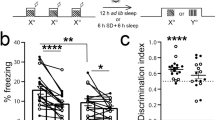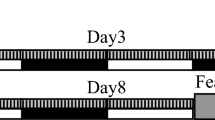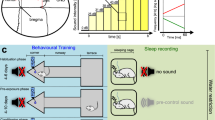Abstract
Sleep can strengthen memory for emotional information, but whether emotional memories can be specifically targeted and modified during sleep is unknown. In human subjects who underwent olfactory contextual fear conditioning, re-exposure to the odorant context in slow-wave sleep promoted stimulus-specific fear extinction, with parallel reductions of hippocampal activity and reorganization of amygdala ensemble patterns. Thus, fear extinction may be selectively enhanced during sleep, even without re-exposure to the feared stimulus itself.
This is a preview of subscription content, access via your institution
Access options
Subscribe to this journal
Receive 12 print issues and online access
$209.00 per year
only $17.42 per issue
Buy this article
- Purchase on Springer Link
- Instant access to full article PDF
Prices may be subject to local taxes which are calculated during checkout


Similar content being viewed by others
References
Walker, M.P. & Stickgold, R. Neuron 44, 121–133 (2004).
Diekelmann, S., Buchel, C., Born, J. & Rasch, B. Nat. Neurosci. 14, 381–386 (2011).
Antony, J.W. et al. Nat. Neurosci. 15, 1114–1116 (2012).
Rasch, B., Buchel, C., Gais, S. & Born, J. Science 315, 1426–1429 (2007).
Bendor, D. & Wilson, M.A. Nat. Neurosci. 15, 1439–1444 (2012).
Barnes, D.C., Chapuis, J., Chaudhury, D. & Wilson, D.A. PLoS ONE 6, e18130 (2011).
Payne, J.D. & Kensinger, E.A. J. Cogn. Neurosci. 23, 1285–1297 (2011).
Arzi, A. et al. Nat. Neurosci. 15, 1460–1465 (2012).
Stout, S.C. & Miller, R. Behav. Processes 66, 7–16 (2004).
Gottfried, J.A. & Dolan, R.J. Nat. Neurosci. 7, 1144–1152 (2004).
Anagnostaras, S.G., Gale, G.D. & Fanselow, M.S. Hippocampus 11, 8–17 (2001).
Milad, M.R. et al. Biol. Psychiatry 62, 446–454 (2007).
Hobin, J.A., Ji, J. & Maren, S. Hippocampus 16, 174–182 (2006).
Burwell, R.D. & Amaral, D.G. J. Comp. Neurol. 398, 179–205 (1998).
Han, J.H. et al. Science 323, 1492–1496 (2009).
Bouton, M.E. Biol. Psychiatry 52, 976–986 (2002).
Herry, C. et al. Nature 454, 600–606 (2008).
Wang, S.H., Teixeira, C.M., Wheeler, A.L. & Frankland, P.W. Nat. Neurosci. 12, 253–255 (2009).
Huff, N.C., Hernandez, J.A., Blanding, N.Q. & LaBar, K.S. Behav. Neurosci. 123, 834–843 (2009).
Mednick, S.C. et al. Trends Neurosci. 34, 504–514 (2011).
Li, W., Howard, J.D., Parrish, T.B. & Gottfried, J.A. Science 319, 1842–1845 (2008).
Howard, J.D. et al. Nat. Neurosci. 12, 932–938 (2009).
Cousineau, D. Tutorials Quant. Meth. Psych. 1, 42–45 (2005).
Iber, C., Ancoli-Israel, S., Chesson, A.L. & Quan, S.F. (American Academy of Sleep Medicine, 2007).
Delorme, A. & Makeig, S. J. Neurosci. Methods 134, 9–21 (2004).
Esterman, M., Tamber-Rosenau, B.J., Chiu, Y.C. & Yantis, S. Neuroimage 50, 572–576 (2010).
Mai, J.K., Assheuer, J. & Paxinos, G. Atlas of the Human Brain (Academic Press, 1997).
Acknowledgements
We thank P. Zee, C. Westerberg and K.N. Wu for technical assistance, and J. Radulovic and K. Paller for insightful discussions. Support was provided from the US National Institutes of Health to K.K.H. (F32MH091967, T32NS047987) and to J.A.G. (R01DC010014, R21DC012014), and from the Northwestern University Center for Translational Imaging.
Author information
Authors and Affiliations
Contributions
K.K.H. conceived the experiment. K.K.H. and J.A.G. designed the research. K.K.H. conducted the research and analyzed the data. J.D.H. performed multivariate analyses. C.Z. performed spectral power analysis. All of the authors prepared the manuscript.
Corresponding author
Ethics declarations
Competing interests
The authors declare no competing financial interests.
Supplementary information
Supplementary Text and Figures
Supplementary Tables 1–3 and Supplementary Figures 1 and 2 (PDF 2790 kb)
Rights and permissions
About this article
Cite this article
Hauner, K., Howard, J., Zelano, C. et al. Stimulus-specific enhancement of fear extinction during slow-wave sleep. Nat Neurosci 16, 1553–1555 (2013). https://doi.org/10.1038/nn.3527
Received:
Accepted:
Published:
Issue Date:
DOI: https://doi.org/10.1038/nn.3527
This article is cited by
-
From childhood adversity to latent stress vulnerability in adulthood: the mediating roles of sleep disturbances and HPA axis dysfunction
Neuropsychopharmacology (2023)
-
Sleep-Directed Hypnosis Improves Subjective Sleep Quality but not Extinction Memory After Exposure to Analog Trauma
Cognitive Therapy and Research (2023)
-
Muskelin regulates actin-dependent synaptic changes and intrinsic brain activity relevant to behavioral and cognitive processes
Communications Biology (2022)
-
Investigating the effect of a nap following experimental trauma on analogue PTSD symptoms
Scientific Reports (2021)
-
Neurochemical mechanisms for memory processing during sleep: basic findings in humans and neuropsychiatric implications
Neuropsychopharmacology (2020)



